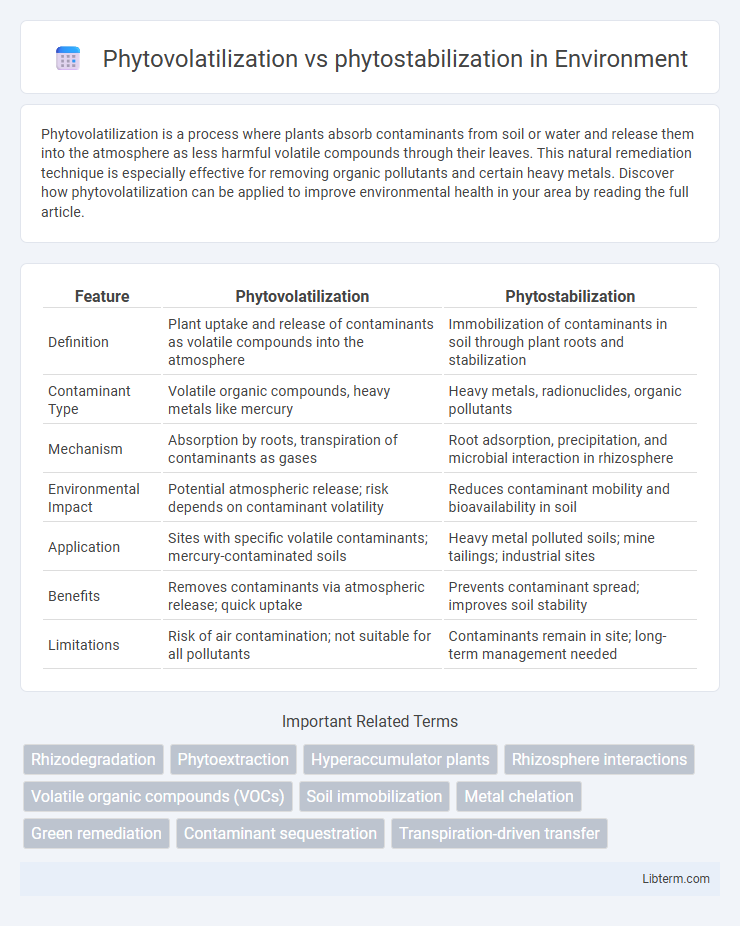Phytovolatilization is a process where plants absorb contaminants from soil or water and release them into the atmosphere as less harmful volatile compounds through their leaves. This natural remediation technique is especially effective for removing organic pollutants and certain heavy metals. Discover how phytovolatilization can be applied to improve environmental health in your area by reading the full article.
Table of Comparison
| Feature | Phytovolatilization | Phytostabilization |
|---|---|---|
| Definition | Plant uptake and release of contaminants as volatile compounds into the atmosphere | Immobilization of contaminants in soil through plant roots and stabilization |
| Contaminant Type | Volatile organic compounds, heavy metals like mercury | Heavy metals, radionuclides, organic pollutants |
| Mechanism | Absorption by roots, transpiration of contaminants as gases | Root adsorption, precipitation, and microbial interaction in rhizosphere |
| Environmental Impact | Potential atmospheric release; risk depends on contaminant volatility | Reduces contaminant mobility and bioavailability in soil |
| Application | Sites with specific volatile contaminants; mercury-contaminated soils | Heavy metal polluted soils; mine tailings; industrial sites |
| Benefits | Removes contaminants via atmospheric release; quick uptake | Prevents contaminant spread; improves soil stability |
| Limitations | Risk of air contamination; not suitable for all pollutants | Contaminants remain in site; long-term management needed |
Introduction to Phytoremediation Techniques
Phytovolatilization and phytostabilization are essential phytoremediation techniques for mitigating environmental contamination. Phytovolatilization involves the uptake and conversion of pollutants into volatile compounds released into the atmosphere, primarily used for organic contaminants like chlorinated solvents. Phytostabilization, on the other hand, immobilizes heavy metals and contaminants in the soil through root absorption and precipitation, preventing their migration and reducing bioavailability.
Understanding Phytovolatilization
Phytovolatilization is a phytoremediation process where plants absorb contaminants, primarily volatile organic compounds or heavy metals, from the soil or water and release them into the atmosphere through transpiration. This mechanism is particularly effective for dealing with pollutants like mercury and selenium, converting them into less harmful gaseous forms and thus reducing soil and water toxicity. Understanding phytovolatilization is crucial for deploying appropriate plant species and optimizing conditions to enhance the volatilization rates, ensuring effective remediation while minimizing environmental risks.
Mechanisms of Phytovolatilization
Phytovolatilization involves the uptake and transformation of contaminants by plants, which then release volatile compounds into the atmosphere through transpiration. This mechanism relies on the plant's ability to metabolize pollutants such as heavy metals or organic compounds into less harmful, vaporized forms. Root absorption followed by enzymatic conversion and subsequent volatilization differentiates phytovolatilization from phytostabilization, where contaminants are immobilized in the soil without being converted or released.
Overview of Phytostabilization
Phytostabilization is a remediation technique that immobilizes contaminants in soil or groundwater through plant roots, preventing their migration and reducing bioavailability. This method is effective for heavy metals and metalloids in mining and industrial sites, as plants stabilize pollutants without extracting them. Compared to phytovolatilization, which transforms contaminants into gaseous forms released into the atmosphere, phytostabilization emphasizes in-situ containment and long-term site stabilization.
Mechanisms of Phytostabilization
Phytostabilization involves the absorption and immobilization of contaminants such as heavy metals by plant roots, preventing their migration through soil or water. This mechanism relies on root exudates that facilitate the precipitation or adsorption of pollutants, reducing their bioavailability and leaching. Unlike phytovolatilization, which transforms contaminants into volatile forms released into the atmosphere, phytostabilization focuses on containment and stabilization within the rhizosphere.
Key Differences: Phytovolatilization vs Phytostabilization
Phytovolatilization involves plants absorbing contaminants and releasing them into the atmosphere as volatile compounds, primarily used for pollutants like mercury and selenium. Phytostabilization, on the other hand, immobilizes contaminants in soil through root absorption, adsorption, or precipitation, preventing their migration without removing them from the site. Key differences include the fate of contaminants--volatilized into air in phytovolatilization versus stabilized in soil during phytostabilization--and the types of pollutants effectively treated by each method.
Environmental Benefits of Each Method
Phytovolatilization enhances environmental quality by transforming contaminants into less harmful volatile compounds released into the atmosphere, effectively reducing soil and groundwater toxicity. Phytostabilization prevents the spread of pollutants by immobilizing heavy metals and other contaminants within the root zone, thereby stabilizing soil structure and minimizing erosion and leaching risks. Both methods contribute to ecosystem restoration by utilizing plants to mitigate pollution, but phytovolatilization is particularly advantageous for contaminants amenable to volatilization, while phytostabilization excels in long-term site stabilization.
Plant Species Used in Phytovolatilization and Phytostabilization
Phytovolatilization commonly involves plant species such as poplars (Populus spp.) and willows (Salix spp.) that uptake and convert contaminants like mercury and selenium into volatile forms released into the atmosphere. Phytostabilization primarily utilizes grasses like Festuca arundinacea and shrubs such as vetiver (Chrysopogon zizanioides) to immobilize heavy metals and prevent soil erosion by stabilizing contaminants in the root zone. These plant species are selected for their specific abilities to tolerate, accumulate, or transform pollutants, making them essential for targeted remediation strategies.
Limitations and Challenges
Phytovolatilization faces challenges such as the potential release of toxic volatile compounds into the atmosphere, which may cause secondary pollution and limit its application to specific contaminants like mercury. Phytostabilization is limited by its inability to reduce contaminant concentrations, simply immobilizing pollutants in the soil and requiring long-term management to prevent remobilization. Both techniques struggle with variations in plant species effectiveness, site-specific soil properties, and contaminant bioavailability, which hinder widespread implementation and consistent remediation outcomes.
Future Perspectives in Phytoremediation
Phytovolatilization leverages plants to uptake and release volatile contaminants into the atmosphere, offering potential for remediation of organic pollutants in soils and waters. Phytostabilization immobilizes heavy metals and toxic elements within the root zone, preventing contaminant migration and reducing bioavailability. Future perspectives emphasize integrating molecular techniques and bioengineering to enhance plant tolerance and degradation efficiency, enabling scalable and sustainable phytoremediation solutions for diverse environmental pollutants.
Phytovolatilization Infographic

 libterm.com
libterm.com